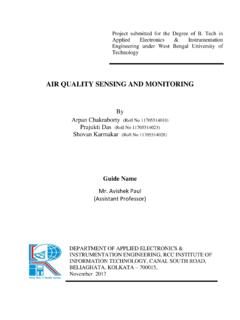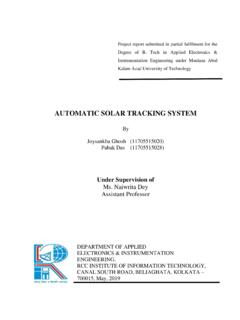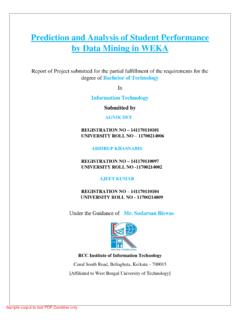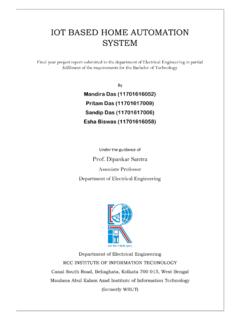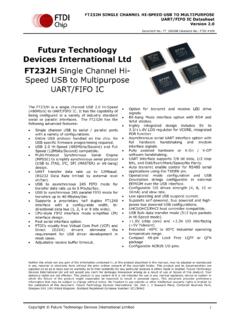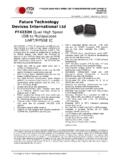Transcription of HOME AUTOMATION USING ARDUINO - Rcciit
1 1 home AUTOMATION USING ARDUINO by Name Roll No. Registration No: ANIRBAN BHOWMIK 11700314015 141170110197 of 2014- 2015 SANDIP KUMAR DAS 11700314080 141170110262 of 2014-2015 SOUVIK ACHARYA 11700314107 141170110289 of 2014-2015 TUSHARKANTI MURMU 11700315146 151170120047 of 2015-2016 A comprehensive project report has been submitted in partial fulfillment of the requirements for the degree of Bachelor of Technology in ELECTRONICS & COMMUNICATION ENGINEERING Under the supervision of Debnath Professor Department of Electronics & Communication Engineering RCC INSTITUTE OF INFORMATION TECHNOLOGY Affiliated to Maulana Abul Kalam Azad University of Technology, WestBengal CANAL SOUTH ROAD, BELIAGHATA, KOLKATA 700015 May,2018 2 CERTIFICATE OF APPROVAL This is to certify that the project titled home AUTOMATION SYSTEM USING ARDUINO carried out by Name Roll No. Registration No: ANIRBAN BHOWMIK 11700314015 141170110197 of 2014- 2015 SANDIP KUMAR DAS 11700314080 141170110262 of 2014-2015 SOUVIK ACHARYA 11700314107 141170110289 of 2014-2015 TUSHARKANTI MURMU 11700315146 151170120047 of 2015-2016 for the partial fulfillment of the requirements for degree in Electronics and Communication Engineering from Maulana Abul Kalam Azad University of Technology, West Bengalis absolutely based on his own work under the supervision of Mrs.
2 Pampa Debnath. The contents of this thesis, in full or in parts, have not been submitted to any other Institute or University for the award of any degree or diploma.. Dr. Abhishek Basu Head of the Department (ECE) RCC Institute of Information Technology Optional in case of External Supervisor .. Designation and Department Institute .. Professor , Dept. of ECE RCC Institute of Information Technology 3 DECLARATION We Do hereby declare that this submission is our own work conformed to the norms and guidelines given in the Ethical Code of Conduct of the Institute and that, to the best of our knowledge and belief, it contains no material previously written by another neither person nor material (data, theoretical analysis, figures, and text) which has been accepted for the award of any other degree or diploma of the university or other institute of higher learning, except where due acknowledgement has been made in the text.
3 Anirban Bhowmik Registration No:141170110197 OF 2014-2015 Roll No: 11700314015 .. Sandip Kumar Das Registration No:141170110262 OF 2014-2015 Roll No:11700314080 .. Souvik Acharya Registration No:141170110289 OF 2014-2015 Roll No: 11700314107 .. Tusharkanti Murmu Registration No:151170120047 OF 2015-2016 Roll No: 11700315146 Date: Place: 4 CERTIFICATE of ACCEPTANCE This is to certify that the project titled home AUTOMATION SYSTEM USING ARDUINO carried out by Name Roll No. Registration No: ANIRBAN BHOWMIK 11700314015 141170110197 of 2014- 2015 SANDIP KUMAR DAS 11700314080 141170110262 of 2014-2015 SOUVIK ACHARYA 11700314107 141170110289 of 2014-2015 TUSHARKANTI MURMU 11700315146 151170120047 of 2015-2016 is hereby recommended to be accepted for the partial fulfillment of the requirements for degree in Electronics and Communication Engineering from Maulana Abul Kalam Azad University of Technology, West Bengal Name of the Examiner Signature with Date 1.
4 <<<<<<<<<<<<<<<<<<<<<<<<<< 2.<<<<<<<<<<<<<< ..<<<<<<<<<<<.. 3.<<<<<<<<<<<<<< <<<<<<<<<<<< 4. <<<<<<<<<<<<<<. <<<<<<<<<<<< 5 ABSTRACT The main objective of this project is to develop a home AUTOMATION system USING an ARDUINO board with Bluetooth being remotely controlled by any Android OS smart phone. As technology is advancing so houses are also getting smarter. Modern houses are gradually shifting from conventional switches to centralized control system, involving remote controlled switches. Presently, conventional wall switches located in different parts of the house makes it difficult for the user to go near them to operate. Even more it becomes more difficult for the elderly or physically handicapped people to do so. Remote controlled home AUTOMATION system provides a most modern solution with smart phones. In order to achieve this, a Bluetooth module is interfaced to the ARDUINO board at the receiver end while on the transmitter end, a GUI application on the cell phone sends ON/OFF commands to the receiver where loads are connected.
5 By touching the specified location on the GUI, the loads can be turned ON/OFF remotely through this technology. The loads are operated by ARDUINO board through opto- isolators and thyristors USING triacs. 6 CONTENTS CERTIFICATE of LIST OF COMPONENTS BLOCK DIAGRAM ..40 CIRCUIT APPLICATION ..45 7 LIST OF FIGURES FIG 1 ARDUINO UNO R3 PAGE 12 FIG 2 2 CHANNEL RELAY PAGE 30 FIG 3 2 CHANNEL RELAY PAGE 33 FIG 4 BLUETOOTH MODULE PAGE 36 FIG 5 PIN DESCRIPTION OF BLUETOOTH MODULE PAGE 36 FIG 6 BLOCK DIAGRAM PAGE 39 FIG 7 CIRCUIT DIAGRAM PAGE 40 8 INTRODUCTION Nowadays, we have remote controls for our television sets and other electronic systems, which have made our lives real easy. Have you ever wondered about home AUTOMATION which would give the facility of controlling tube lights, fans and other electrical appliances at home USING a remote control? Off-course, Yes! But, are the available options cost-effective?
6 If the answer is No, we have found a solution to it. We have come up with a new system called ARDUINO based home AUTOMATION USING Bluetooth. This system is super-cost effective and can give the user, the ability to control any electronic device without even spending for a remote control. This project helps the user to control all the electronic devices USING his/her smartphone. Time is a very valuable thing. Everybody wants to save time as much as they can. New technologies are being introduced to save our time. To save people s time we are introducing home AUTOMATION system USING Bluetooth . With the help of this system you can control your home appliances from your mobile phone. You can turn on/off your home appliances within the range of Bluetooth. 9 COMPONENTS REQUIRED 1) ARDUINO UNO 2)2 CHANNEL RELAY(5v) 3)BLUETOOTH MODULE HC05 4)POWER SUPPLY 5)LOAD(BULB 220V) 6)CONNECTING WIRES 7)VERO BOARD 8)SMARTPHONE(BLUETOOTH ENABLED) 10 DESCRIPTION ARDUINO UNO ARDUINO is an open source computer hardware and software company, project, and user community that designs and manufactures single-board microcontrollers and microcontroller kits for building digital devices and interactive objects that can sense and control objects in the physical and digital world.
7 The project's products are distributed as open-source hardware and software, which are licensed under the GNU Lesser General Public License (LGPL) or the GNU General Public License (GPL), permitting the manufacture of ARDUINO boards and software distribution by anyone. ARDUINO boards are available commercially in preassembled form, or as do-it-yourself (DIY) kits. ARDUINO board designs use a variety of microprocessors and controllers. The boards are equipped with sets of digital and analog input/output (I/O) pins that may be interfaced to various expansion boards or Breadboards (shields) and other circuits. The boards feature serial communications interfaces, including Universal Serial Bus (USB) on some models, which are also used for loading programs from personal computers. The microcontrollers are typically programmed USING a dialect of features from the programming languages C and C++. In addition to USING traditional compiler toolchains, the ARDUINO project provides an integrated development environment (IDE) based on the Processing language project.
8 The ARDUINO project started in 2003 as a program for students at the Interaction Design Institute Ivrea in Ivrea, Italy, aiming to provide a low-cost and easy way for novices and professionals to create devices that interact with their environment USING sensors and actuators. Common examples of such devices intended for beginner hobbyists include simple robots, thermostats, and motion detectors. 11 The name ARDUINO comes from a bar in Ivrea, Italy, where some of the founders of the project used to meet. The bar was named after Arduin of Ivrea, who was the margrave of the March of Ivrea and King of Italy from 1002 to 1014. Features of the ARDUINO UNO: Microcontroller: ATmega328 Operating Voltage: 5V Input Voltage (recommended): 7-12V Input Voltage (limits): 6-20V Digital I/O Pins: 14 (of which 6 provide PWM output) Analog Input Pins: 6 DC Current per I/O Pin: 40 mA DC Current for Pin: 50 mA Flash Memory: 32 KB of which KB used by bootloader SRAM: 2 KB (ATmega328) EEPROM: 1 KB (ATmega328) Clock Speed: 16 MHz 12 FIG 1 ARDUINO UNO R3 13 ARDUINO HARDWARE PART:- ARDUINO is open-source hardware.
9 The hardware reference designs are distributed under a Creative Commons Attribution Share-Alike license and are available on the ARDUINO website. Layout and production files for some versions of the hardware are also available. Although the hardware and software designs are freely available under copyleft licenses, the developers have requested the name Arduinoto be exclusive to the official product and not be used for derived works without permission. The official policy document on use of the ARDUINO name emphasizes that the project is open to incorporating work by others into the official product. Several ARDUINO -compatible products commercially released have avoided the project name by USING various names ending in -duino. Most ARDUINO boards consist of an Atmel 8-bit AVR microcontroller (ATmega8, ATmega168, ATmega328, ATmega1280, ATmega2560) with varying amounts of flash memory, pins, and features. The 32-bit ARDUINO Due, based on the Atmel SAM3X8E was introduced in 2012.
10 The boards use single or double-row pins or female headers that facilitate connections for programming and incorporation into other circuits. These may connect with add-on modules termed shields. Multiple and possibly stacked shields may be individually addressable via an I C serial bus. Most boards include a 5 V linear regulator and a 16 MHz crystal oscillator or ceramic resonator. Some designs, such as the LilyPad, run at 8 MHz and dispense with the onboard voltage regulator due to specific form-factor restrictions. ARDUINO microcontrollers are pre-programmed with a boot loader that simplifies uploading of programs to the on-chip flash memory. The default bootloader of the ARDUINO UNO is the optiboot bootloader. Boards are loaded with program code via a serial connection to another computer. Some serial ARDUINO boards contain a level shifter circuit to convert between RS-232 logic levels and transistor transistor logic(TTL) level signals. Current ARDUINO boards are programmed via Universal Serial Bus (USB), implemented USING USB-to-serial adapter chips such as the FTDI ft232 .
